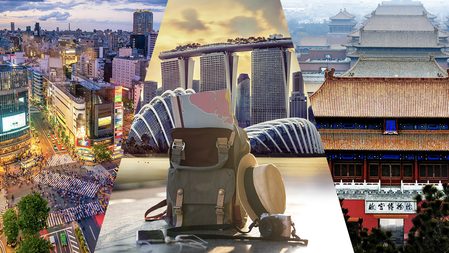Filipinos’ revenge travel, cheaper China products hurt sales of local appliances
Panasonic Philippines attributes Filipino consumers' 'spending shift mostly to travel' and 'aggressive promotions' of China products for the company's lower sales in 2023
MANILA, Philippines – Filipinos are “intense” about fulfilling their travel goals on their bucket list – so much so that it has impacted sales of home appliances.
That’s according to one of the largest appliance manufacturers and distributors in the Philippines.
Filipinos are prioritizing spending on travel over purchases of appliances and other products as revenge travel continues post-pandemic.
Panasonic Manufacturing Philippines Corporation (Panasonic Philippines) disclosed on Friday, July 12, that sales of its Panasonic appliances and other products were lower in 2023 due partly to Filipino consumers opting to spend more on travel.
It also attributed its lower sales performance to cheaper China products, “demand slowness in export,” high interest rates, and high inflation.
Based on its 2023 annual report, Panasonic Philippines said its P14.3-billion sales in 2023 were lower by 94% than in 2022.
It cited Filipino consumers’ “spending shift mostly to travel,” as well as “the emergence of China brand products with lower selling price,” as among the reasons for lower sales.
And, it’s not just the spending shift to travel, said Panasonic Philippines, but the “spending intensity.”
Elaborating on the rise of Chinese appliances, Panasonic Philippines said market competition has seen the “emergence of China products with aggressive promotions.”
The price difference between established local manufacturers’ appliances and many Chinese imports is big. For instance, an 8.5 kilogram (kg) fully automatic washing machine of established brands are twice more expensive than some 8 kg fully automatic China brands, a check with a major e-commerce site in the Philippines showed. Another e-commerce site showed that established brands’ air conditioners can be as high as double the price of some China brands.
Panasonic Philippines’ main products are refrigerators, air conditioners, washing machines, electric fans, freezers, and flat irons. It also sells imported appliances such as LCD TV sets, video and still cameras, corded and cordless telephones, batteries, and office equipment such as POS machines.
Panasonic air conditioners contributed P514.9 million to overall sales in 2023 (15%), followed by P398 million for washing machines (18%), and P381 million for refrigerators. Export sales of its air conditioners, mostly to Hong Kong and Taiwan, reached P1.18 billion.
Panasonic’s main competitors among established brands in the Philippines are Carrier, TCL, Samsung, Condura, Daikin, and Haier for air conditioners; Samsung, LG, Haier, Condura, and Sharp for refrigerators; and LG, Samsung, Sharp, Haier, TCL, and Condura for washing machines.
In response to the sales slowdown, Panasonic Philippines stressed the quality of its products, adding that its sales and marketing group had drawn up “various strategies, including but not limited to winning the competition by Brand Value and One Panasonic approach.”
Panasonic Philippines was incorporated in the Philippines in 1963. It is a subsidiary of Japan’s Panasonic Holdings Corporation.
Revenge travel continues
Various official data showed that Filipino revenge travel continued in 2023. The number of Filipino travelers is moving close to the peak of over 8 million reached in 2019, or the year before COVID-19 shuttered global travel.
Although the available data from the Bureau of Immigration’s (BI) latest accomplishment report do not categorize the purpose of travel, it nonetheless gives a good picture of revenge travel.

According to the BI, there were 1.3 million Filipino departures in 2021 when travel restrictions were liberalized. In 2022, it rose to 2.4 million departures. And, in 2023, it jumped to 7.2 million departures or three times more.
Since the 2023 departure figure of Filipinos includes 2.33 million deployed overseas Filipino Workers (OFWs) in 2023, this means there were 4.9 million departures who were non-OFWs, and most of them left for pleasure.
“A lot of Filipinos…traveled this year [2023] as countries reopened their borders after the pandemic,” said BI chief Commissioner Norman Tansingco in a January 2024 press release.
Hong Kong, Singapore, and Japan have been the top three destinations of Filipinos in the past 12 months, according to Department of Tourism data.
Outbound Philippine Residents – Filipino Nationals – by Country of Destination
| Destination | May to December 2023 | January to June 2024 |
|---|---|---|
| Hong Kong – SAR | 494,437 | 425,143 |
| Singapore | 450,406 | 394,801 |
| Japan | 398,511 | 391,548 |
Hong Kong and Singapore require no visa from Filipinos, while Japan liberalized entry to Filipinos and other ASEAN nationals back in 2013.
Hong Kong tourism data showed 715,214 Filipino tourist arrivals in 2023, a 3,497% growth from the 21,046 in 2022. The upward trend has continued this year. In the first three months of 2024, there were 433,810 tourists from the Philippines in Hong Kong compared to 208,846 in the same period in 2023, an increase of 107%, according to Hong Kong Tourism Board statistics.

Japan has also become a major destination for Filipinos. Filipinos were the eighth biggest source of visitors to Japan in the first three months of 2024, next to visitors from South Korea, Taiwan, China, Hong Kong, US, Thailand, and Australia, based on the preliminary Japan National Tourism Organization figures from January to March.
Filipinos spend around P46,000 when they travel to Japan, according to a survey by Japan’s tourism agency.
Philippine Statistics Authority data also showed that the Philippines’ outbound tourism expenditures have also strongly rebounded.
From a peak of P340 billion in pre-pandemic 2019, falling to P78 billion in 2020, it rebounded to P189 billion in 2022 and P208 billlion in 2023.
The United Nations World Tourism Organization data showed higher figures of $12 billion in the Philippines’ international tourism expenditures in pre-pandemic 2019, which fell to $3.2 billion 2021. It has since been on an uptrend at $4.9 billion in 2022 and $6.6 billion in 2023. – Rappler.com

![[ANALYSIS] Reflections on Japan’s cherry blossom tourism](https://www.rappler.com/tachyon/2024/05/20240413_113501-scaled.jpg?fit=449%2C449)
